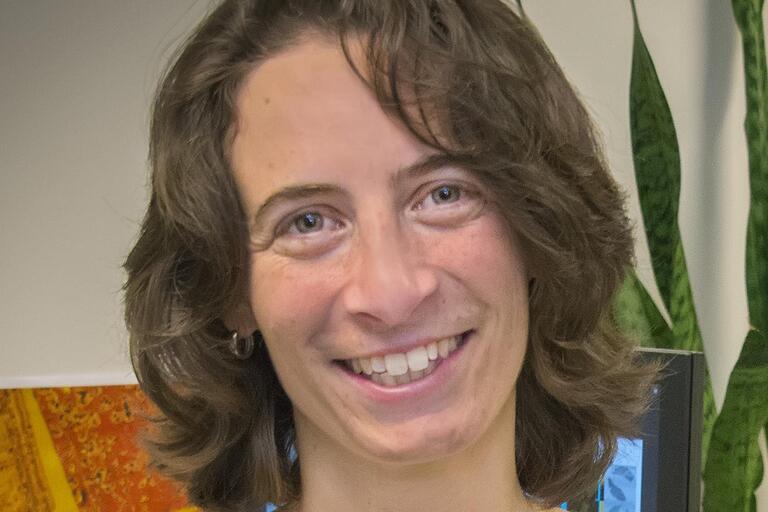Naomi S. Ginsberg is an Associate Professor of Chemistry and Physics at the University of California, Berkeley, and a Faculty Scientist in the Materials Sciences and Molecular Biophysics and Integrated Imaging Divisions at Lawrence Berkeley National Laboratory, where she has been since 2010. She currently focuses on elucidating the electronic and molecular dynamics in a wide variety of soft electronic and biological materials by devising new electron and optical imaging modalities that enable characterization of fast and ultrafast processes at the nanoscale and as a function of their heterogeneities. Naomi received a B.A.Sc. degree in Engineering Science from the University of Toronto in 2000 and a Ph.D. in Physics from Harvard University in 2007, after which she held a Glenn T. Seaborg Postdoctoral Fellowship at Lawrence Berkeley National Lab. Her background in chemistry, physics, and engineering has previously led her to observe initiating events of photosynthesis that take place in a millionth billionth of a second and to slow, stop, and store light pulses in some of the coldest atom clouds on Earth. She is the Berkeley lead of STROBE, a multi-university NSF Science and Technology Center devoted to imaging science, a member of the Kavli Energy Nanoscience Institute at Berkeley, and the recipient of a David and Lucile Packard Fellowship in Science and Engineering (2011), a DARPA Young Faculty Award (2012), an Alfred P. Sloan Foundation Fellowship (2015), and a Camille Dreyfus Teacher-Scholar Award (2016) in addition to a series of teaching awards in the physical sciences. In 2017-18 she was a Miller Professor for Basic Research in Science at UC Berkeley and was designated a Kavli Fellow. In 2019 she was the Kroto Lecturer in Chemical Physics at Florida State University. She is the recipient of the 2020 ACS Early-Career Award in Experimental Physical Chemistry and became a Fellow of the American Physical Society in 2021. She received the Carol D. Soc Distinguished Graduate Student Mentoring Award in 2022.
Research Interests
Many investigations in the Ginsberg group concern the fundamental properties and mechanisms of the formation and emergent properties of hierarchical materials – materials that include a hierarchy of bond strengths because their basic building blocks, molecules or nanoparticles, are more complex than individual atoms. Hierarchical materials present a wide array of underexplored phase behaviors and emergent properties. While everyday examples range from glasses and plastics to QD and OLED displays, hierarchical materials also include biological assemblies, a vast array of next-generation semiconductors that can be formed with far more modest protocols than conventional ones are are being explored for solar cells and other energy-related applications, and metal organic frameworks being celebrated for their porosity amenable to selective gas adsorption, nanoreactions, and catalytic function.
Taking electronic materials—semiconductors or conductors—as an example, one can easily imagine how the various structures of solids formed from these components would impact the band structure in ways that are more challenging to orchestrate with individual atoms alone. These building blocks take up space and can be anisotropic or have different symmetries than atoms do on their own, which offers the exciting possibility to create materials with new and different emergent properties well beyond their bulk moduli. The weaker bonds between building blocks even permit close-to-room temperature material formation from precursors. One current related hallmark of the typical structures of hierarchical materials, however, is that they are often trapped far from equilibrium, presenting the opportunity to investigate how local structural variations or other heterogeneities affect their emergent properties.
How are hierarchical materials’ structures and the processes by which they are formed similar to or different from atomic materials? Since these materials involve multiple interdependent forces determining the complex configurations of their building blocks, how do these add or balance at different scales in order to self assemble and how could these interactions be manipulated to best stabilize their structures either in- or out equilibrium? How do their emergent properties, such as various forms of energy transport relate to their unique structures?
To address these questions we develop and employ a wide range of characterization strategies to follow the nanoscale dynamics of hierarchical material formation, phase transformations, and energy transport, tailoring the length and time scales accessible to the particular processes at hand and taking care to mitigate damage. These range from a suite of in situ low-exposure scanning electron and cathodoluminescence microscopies and in situ storage ring and free electron laser hard X-ray scattering techniques for following material assembly and other phase transitions to ultrafast optical spatiotemporally resolved microscopies to relate energy transport to structure. These allow us to investigate the fundamental microscopic mechanisms responsible for remarkable non-equilibrium, triggered, or driven processes in a wide range of frontier semiconductors, including organics, metal halide perovskites, covalent organic frameworks, 2D materials, nanocrystal superlattices, ion conducting materials important for solar fuels generation, natural and biomimetic photosynthetic light harvesting, and model systems.
Publications
Professor Naomi Ginsberg's publications can be found here.

